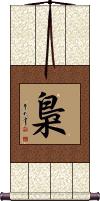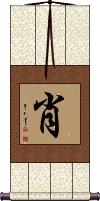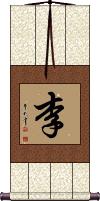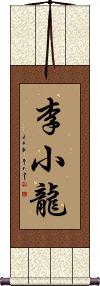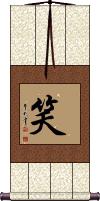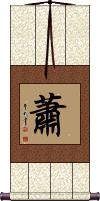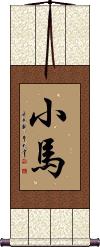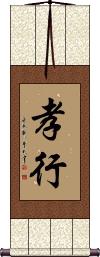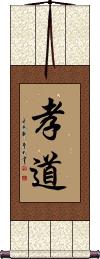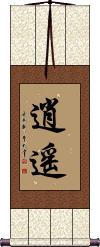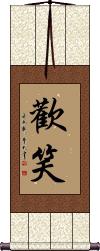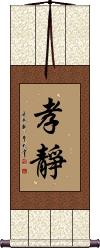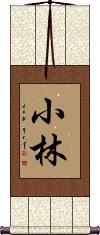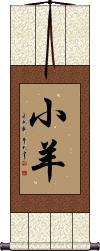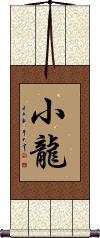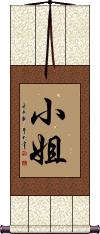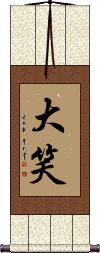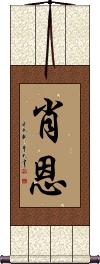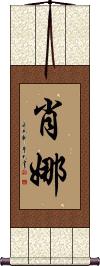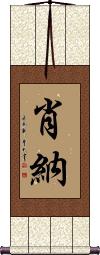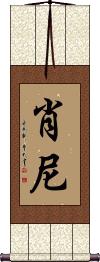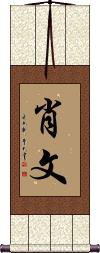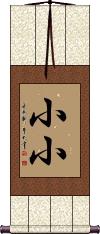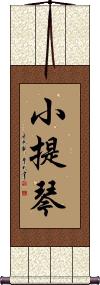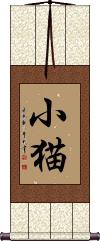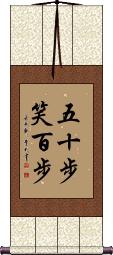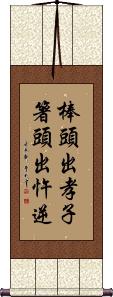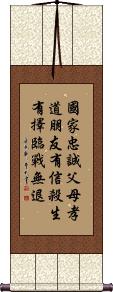Many custom options...
And formats...

Xiao in Chinese / Japanese...
Buy a Xiao calligraphy wall scroll here!
Personalize your custom “Xiao” project by clicking the button next to your favorite “Xiao” title below...
1. Owl
2. Filial Piety
3. Shaw
4. Lee / Plum
5. Bruce Lee
6. Easy-Going
8. Siu
9. Siew
10. Colt
11. Filial Piety / Filial Conduct
14. Happy Laughter
15. Hyo-Jung
17. Lamb
18. Little Dragon
19. Missy
20. Roar of Laughter / Big Laughs
21. Sean
22. Shaen
23. Shane
24. Shaun
25. Shauna
26. Shaunna
27. Shawn
28. Shawna
29. Shawnee
30. Shovon
32. Xiaoxiao
33. Dashawn
34. Deshaun
35. Deshawn
36. D’Shaun
37. D’Shawn
38. Eshan
40. Horatio
41. Kaishawn
43. Scholz
44. Shawnette
45. Shokri
46. Shonet
47. Violin
48. Shaunte
49. Dashaun
50. Kishon
51. Shornelle
52. Shoshone
53. Kitten / Young Cat / Little Cat
55. Holding Flowers with Subtle Smile
56. The Whole Room Rocks With Laughter
58. Live Laugh Love
59. Love Between Child and Parents
61. Shawntel
62. Shawntrell
63. The one who retreats 50 paces mocks the one to retreats 100
梟 is the generic title for an owl in Chinese, Japanese Kanji, and old Korean Hanja.
Often this refers to the Ural owl (Strix uralensis)
In some contexts, it can also mean valiant or refer to a trafficker.
Filial Piety
孝 represents filial piety.
Some will define this in more common English as “respect for your parents and ancestors.”
孝 is a subject deeply emphasized by the ancient philosophy and teachings of Confucius.
Some have included this in the list for the Bushido, although generally not considered part of the 7 core virtues of the warrior.
Note: 孝 is not the best of meanings when seen as a single character. Some will read the single-character form to mean “missing my dead ancestors.” However, when written as part of Confucian tenets, or in the two-character word that means filial piety, the meaning is better or read differently (context is important for this character).
We suggest one of our other two-character filial piety entries instead of this one.
Shaw
Lee / Plum
This is the most common Chinese character which sounds like “Lee” or “Li” and is used as a surname / family name in China.
李 actually means “Plum.” So it's really Mr. Plum and Mrs. Plum if you translated the name instead of romanizing.
This is not the only character in Chinese that can be romanized as “Lee” or “Li.” If your family name is “Lee” or “Li” please be sure this is the correct character before you order this scroll (look at your grandparents' Chinese passports or other documents if you are an ABC and are trying to create a heritage wall scroll).
Famous people with this surname include Bruce Lee (Li Xiao-Long), Minister Li Peng, and famous Tang Dynasty poet Li Bai.
In Korea, this is the original character for a surname that romanizes as “Yi.”
Note: This also one version of Lee that is a common Korean surname. However, it’s often romanized as "Yi" and sometimes as "Ri" or "Rhee."
Bruce Lee
李小龍 is the real full name of Bruce Lee.
 Many people have no idea that Bruce Lee had a “real” Chinese name. In Mandarin and Cantonese, he is known as “Lǐ XiǎoLóng” and “Léi SíuLùng” respectively.
Many people have no idea that Bruce Lee had a “real” Chinese name. In Mandarin and Cantonese, he is known as “Lǐ XiǎoLóng” and “Léi SíuLùng” respectively.
He kept his family name pronunciation (Li = Lee). 李 is a common family name that also means “plum.”
His given name 小龍 (Xiao-Long), literally means “little dragon.” 李小龍 is why you often see the character for dragon associated with Bruce Lee on various posters etc.
For a pronunciation lesson, the “X” in Romanized Mandarin is pronounced like a “sh” sound but with your tongue at the bottom of your mouth. The vowel sound in “Long” is like the English “oh,” not like the “ah” sound in the English word “long.”
If you are a big Bruce Lee fan, you should know this information, and you should have this wall scroll hanging in your room or martial arts studio.
Note: Japanese use these same Chinese characters / Kanji to write Bruce Lee's real name (with different pronunciation - which is a bit like how the name “Bruce Lee” sounds in English).
See Also: Kung Fu | Martial Arts
Easy-Going
逍 is a Chinese word that means leisurely or easy-going.
In some contexts, it can mean roaming or sauntering.
This can be pronounced as "shou" in Japanese but rarely seen as a single Kanji in Japan. This is better if your target audience is Chinese.
Laugh / Smile
笑 simply means to laugh or smile.
Notes: In some contexts, it can mean “ridicule” in Korean Hanja. 笑 is not often seen alone in Japanese, though it is understood.
Siew
Colt
Filial Piety / Filial Conduct
孝行 expresses the idea of filial piety or filial conduct.
While the first character means filial piety by itself, the second character adds “action.” Therefore this represents the actions you take to show your respect and obedience to your elders or ancestors.
Confucius is probably the first great advocate for filial piety.
The Dao of Filial Piety
孝道 most clearly expresses the Confucian philosophy of filial piety.
Confucius taught that all should be respectful and obedient to their parents. Included in this idea is honoring your ancestors.
The second character is “dao/tao” or “the way” as in Taoism. You can say this title is “The Tao of Filial Piety” or “The Way of Filial Piety.”
See Also: Confucius
To Be Free / Freedom
逍遙 means freedom in Chinese characters.
This has a well-written meaning for a wall scroll. What I mean by that is while there is a way to say “freedom” orally, this word seems more appropriate for calligraphy. This can also be translated as “free and unfettered” in Chinese.
Note: In Korean and Japanese, this means one who rambles, saunters, or strolls (this entry is best if your audience is Chinese).
Happy Laughter
Hyo-Jung
孝靜 or 효정 is the Korean given name Hyo-Jung or Hyojung.
If you want this name written in Hangul, click the Hangul characters next to the Korean flag above (instead of the big button).
Kobayashi / Shobayashi
Lamb
Little Dragon
Missy
Roar of Laughter / Big Laughs
大笑 can be translated as “roar of laughter,” “loud laughter,” “hearty laugh,” or “cachinnation.”
The first character means big or great, and the second means to laugh or smile.
If you like humor, this is a great wall scroll to hang in your home.
See Also: The Whole Room Rocks With Laughter
Sean
Shaen
Shane
Shaun
Shauna
Shaunna
Shawn
Shawna
Shawnee
Shovon
Tsunami / Tidal Wave
Xiaoxiao
Dashawn
Deshaun
Deshawn
D’Shaun
D’Shawn
Eshan
Firefighter / Fireman
Horatio
Kaishawn
Koushinkan / Koshinkan
孝心館 is the title for Koushinkan, Koshinkan, or Kōshin-Kan.
The romanization of this title varies a little, but the original characters are the same.
孝 = Filial piety or obedience.
心 = Heart, mind, intention, or center.
馆 = Building or establishment (dojo).
This can be pronounced in Chinese and has the same meaning, but you should consider this a Japanese martial arts title.
Scholz
Shawnette
Shokri
Shonet
Violin
Shaunte
Dashaun
Kishon
Shornelle
Shoshone
Kitten / Young Cat / Little Cat
Beware of the Lawyers
提防律師 is a kind of Chinese joke about lawyers.
The first two characters mean “guard yourself against (an attack)” or “beware.”
The last two characters can be translated as lawyer, attorney, or solicitor.
Separately, those characters mean law/regulation/control and master/expert/teacher. Here, you can see the attorney meaning is pretty clear in the individual characters.
Please note this is Chinese only (it won't make sense in Japanese, and the last two characters are sometimes translated together as “Buddhist Priest” in Japanese).
Holding Flowers with Subtle Smile
An idiom for heart-to-heart communication
拈華微笑 is a Chinese, Korean, and Japanese Buddhist title that relays the idea of “heart-to-heart communication,” or “thought transference.”
The literal translation is, “holding a flower and subtly smiling,” or “the holding of a flower with a subtle smile.” It is the visual act and emotion that communicates more volume than words can say.
The Whole Room Rocks With Laughter
The perfect scroll if you love humor or as a gift for the comedian in your life
In China, 哄堂大笑 is a proverb that is used in response to a good joke or witty comment.
The story goes that Mr. Feng and Mr. He were both senior officials in the Song Dynasty (about a thousand years ago). One day, Mr. Feng walked into their shared office wearing a new pair of boots. The boots caught the eye of Mr. He who said, “New boots! - how much were they?.” Mr. Feng lifted one of the boots off the ground as if to show it off and responded, “900 coins.”
Astonished, Mr. Feng explained, “900? How can that be? - I paid 1800 coins for my boots!.” Mr. Feng then lifted his other foot off the ground and said, “This boot was also 900 coins.”
It is said that the whole room was shaking from the laughter of all that heard Mr. Feng's joke on Mr. He.
Laughing Dragon Kung Fu
笑龍功夫 is the title for a Martial Arts studio (custom-made at by request of the owner of the studio).
Live Laugh Love
In English, the word order shown in the title is the most natural or popular. In Chinese, the natural order is a little different:
The first character means laugh (sometimes means smile).
The second character means love.
The last two characters mean “live” as in “to be alive” or “pursue life.”
Please note: 笑愛生活 is not a normal phrase in that it does not have a subject, verb, or object. It is a word list. Word lists are not common in Asian languages/grammar (at least not as normal as in English). We only added this entry because so many people requested it.
We put the characters in the order shown above, as it almost makes a single word with the meaning “A life of laughter and love.” It's a made-up word, but it sounds good in Chinese.
We removed the Japanese pronunciation guide from this entry, as the professional Japanese translator deemed it "near nonsense" from a Japanese perspective. Choose this only if your audience is Chinese and you want the fewest-possible characters to express this idea.
In Korean, this would be 소애생활 or "so ae saeng hwar" but I have not confirmed that this makes sense in Korean.
Love Between Child and Parents
School of Happiness
Shawntel
Shawntrell
The one who retreats 50 paces mocks the one to retreats 100
The pot calls the kettle black
五十步笑百步 is a Chinese proverb that means the one who retreats 50 paces mocks the one who retreats 100 paces.
During the Warring States Period of what is now China (475 - 221 B.C.), the King of Wei was in love with war. He often fought with other kingdoms just for spite or fun.
One day, the King of Wei asked the philosopher Mencius, “I love my people, and all say I do the best for them. I move the people from famine-stricken areas to places of plenty and transport grains from rich areas to the poor. Nobody goes hungry in my kingdom, and I treat my people far better than other kings. But why does the population of my kingdom not increase, and why does the population of other kingdoms not decrease?”
Mencius answered, “Since you love war, I will make this example: When going to war, and the drums beat to start the attack, some soldiers flee for their lives in fear. Some run 100 paces in retreat, and others run 50 steps. Then the ones who retreated 50 paces laugh and taunt those who retreated 100 paces, calling them cowards mortally afraid of death. Do you think this is reasonable?
The King of Wei answered, “Of course not! Those who run 50 paces are just as timid as those who run 100 paces.”
Mencius then said, “You are a king who treats his subjects better than other kings treat their people, but you are so fond of war that your people suffer from great losses in battle. Therefore, your population does not grow. While other kings allow their people to starve to death, you send your people to die in war. Is there any difference?”
This famous conversation led to the six-character proverb shown here. It serves as a warning to avoid hypocrisy. It goes hand-in-hand with the western phrase, “The pot calls the kettle black,” or the Biblical phrase, “Before trying to remove a splinter from your neighbor's eye, first remove the plank from your own eye.”
Spare the Rod, Spoil the Child
棒頭出孝子箸頭出忤逆 literally translates as:
A stick (or switch) produces filial sons; chopsticks produce disobedient [ones].
Figuratively, this means:
Strict discipline produces dutiful children, whereas indulgence produces disobedient ones.
This proverb is very similar to this English proverb:
“Spare the rod and spoil the child.”
Five Codes of Tang Soo Do
国家忠诚父母孝道朋友有信杀生有择临战无退 are the five codes of Tang Soo Do.
I suggest you have this arranged in five columns when you get to the options page for your custom calligraphy wall scroll.
Here are my translations of each of the five codes:
國家忠誠 Be loyal to your country.
父母孝道 In regards to parents, behave in a filial way.
朋友有信 Be faithful in friendship.
殺生有擇 When fighting for life and death, make noble choices.
臨戰無退 No retreat in battle.
Note: “Tang Soo Do” is a romanization of 唐手道. It's 당수도 in Korean Hangul. It can also be romanized as “Tangsudo” or “Dangsudo.”
This in-stock artwork might be what you are looking for, and ships right away...
Not the results for xiao that you were looking for?
Below are some entries from our dictionary that may match your xiao search...
| Characters If shown, 2nd row is Simp. Chinese |
Pronunciation Romanization |
Simple Dictionary Definition |
孝 see styles |
xiào xiao4 hsiao yasuaki やすあき |
More info & calligraphy: Filial Piety(See 孝行・1) filial piety; (given name) Yasuaki Filial, obedient. |
梟 枭 see styles |
xiāo xiao1 hsiao fukurou; fukuro; sake; fukurou / fukuro; fukuro; sake; fukuro ふくろう; ふくろ; さけ; フクロウ |
More info & calligraphy: Owl(kana only) owl (esp. the Ural owl, Strix uralensis) owl |
笑 see styles |
xiào xiao4 hsiao warau わらう |
More info & calligraphy: Laugh / Smile(abbreviation) (slang) LOL; haha; (female given name) Warau to laugh |
肖 see styles |
xiào xiao4 hsiao shiyo しよ |
More info & calligraphy: Shaw(surname) Shiyo |
蕭 萧 see styles |
xiāo xiao1 hsiao shou / sho しょう |
More info & calligraphy: Siew(1) Japanese mugwort (Artemisia princeps, Artemisia indica var. maximowiczii); (2) general term for plants in the Artemisia genus; mugwort; sagebrush; wormwood; (surname) Shou gloomy |
逍 see styles |
xiāo xiao1 hsiao shō |
More info & calligraphy: Easy-GoingTo roam, saunter. |
大笑 see styles |
dà xiào da4 xiao4 ta hsiao taishou / taisho たいしょう |
More info & calligraphy: Roar of Laughter / Big Laughs(n,vs,vi) loud laughter; hearty laugh |
孝道 see styles |
xiào dao xiao4 dao5 hsiao tao takamichi たかみち |
More info & calligraphy: The Dao of Filial Pietyfilial piety; (given name) Takamichi |
小姐 see styles |
xiǎo jie xiao3 jie5 hsiao chieh |
More info & calligraphy: Missy |
小小 see styles |
xiǎo xiǎo xiao3 xiao3 hsiao hsiao shoushou / shosho しょうしょう |
More info & calligraphy: Xiaoxiao(n-adv,n) just a minute; small quantity |
小林 see styles |
xiǎo lín xiao3 lin2 hsiao lin hirokazu ひろかず |
More info & calligraphy: Kobayashi / Shobayashi(personal name) Hirokazu |
小羊 see styles |
xiǎo yáng xiao3 yang2 hsiao yang kohitsuji こひつじ |
More info & calligraphy: Lamblamb |
小馬 小马 see styles |
xiǎo mǎ xiao3 ma3 hsiao ma konma こんま |
More info & calligraphy: Colt(1) small horse; pony; (2) foal; colt; filly; (surname) Konma |
小龍 小龙 see styles |
xiǎo lóng xiao3 long2 hsiao lung |
More info & calligraphy: Little Dragon |
歡笑 欢笑 see styles |
huān xiào huan1 xiao4 huan hsiao |
More info & calligraphy: Happy Laughter |
海嘯 海啸 see styles |
hǎi xiào hai3 xiao4 hai hsiao kaishou / kaisho かいしょう |
More info & calligraphy: Tsunami / Tidal Wave(1) (tidal) bore; eagre; (2) (obsolete) (See 津波) tsunami; tidal wave |
肖恩 see styles |
xiāo ēn xiao1 en1 hsiao en |
More info & calligraphy: Shawn |
逍遙 逍遥 see styles |
xiāo yáo xiao1 yao2 hsiao yao shouyou / shoyo しょうよう |
More info & calligraphy: To Be Free / Freedom(out-dated kanji) (noun/participle) ramble; saunter; walk; wander; stroll; (female given name) Shouyou free and easy |
小提琴 see styles |
xiǎo tí qín xiao3 ti2 qin2 hsiao t`i ch`in hsiao ti chin |
More info & calligraphy: Violin |
李小龍 李小龙 see styles |
lǐ xiǎo lóng li3 xiao3 long2 li hsiao lung |
More info & calligraphy: Bruce Lee |
消防員 消防员 see styles |
xiāo fáng yuán xiao1 fang2 yuan2 hsiao fang yüan |
More info & calligraphy: Firefighter / Fireman |
俲 效 see styles |
xiào xiao4 hsiao |
variant of 傚|效[xiao4] See: 效 |
傚 效 see styles |
xiào xiao4 hsiao |
to imitate (variant of 效[xiao4]) See: 效 |
効 效 see styles |
xiào xiao4 hsiao isao いさお |
variant of 效[xiao4] efficacy; benefit; efficiency; effect; result; success; (given name) Isao |
呺 see styles |
xiāo xiao1 hsiao |
voice of anger; vast; spacious |
咲 笑 see styles |
xiào xiao4 hsiao momoka ももか |
old variant of 笑[xiao4] (female given name) Momoka |
哮 see styles |
xiào xiao4 hsiao takeru たける |
pant; roar; bark (of animals); Taiwan pr. [xiao1] (given name) Takeru |
嘐 see styles |
xiāo xiao1 hsiao |
boastful; bombastic |
嘯 啸 see styles |
xiào xiao4 hsiao |
(of people) to whistle; (of birds and animals) to screech; to howl; to roar |
嘵 哓 see styles |
xiāo xiao1 hsiao |
a cry of alarm; querulous |
Click here for more xiao results from our dictionary
The following table may be helpful for those studying Chinese or Japanese...
| Title | Characters | Romaji (Romanized Japanese) | Various forms of Romanized Chinese | |
| Owl | 梟 枭 | fukurou / sake fukuro / sake | xiāo / xiao1 / xiao | hsiao |
| Filial Piety | 孝 | kou / ko | xiào / xiao4 / xiao | hsiao |
| Shaw | 肖 | xiāo / xiao1 / xiao | hsiao | |
| Lee Plum | 李 | ri / sumomo | lǐ / li3 / li | |
| Bruce Lee | 李小龍 李小龙 | bu ruu su ri buruusuri bu ru su ri | lǐ xiǎo lóng li3 xiao3 long2 li xiao long lixiaolong | li hsiao lung lihsiaolung |
| Easy-Going | 逍 | shou / sho | xiāo / xiao1 / xiao | hsiao |
| Laugh Smile | 笑 | e / shou / wa e / sho / wa | xiào / xiao4 / xiao | hsiao |
| Siu | 蕭 萧 | xiāo / xiao1 / xiao | hsiao | |
| Siew | 蕭 萧 | xiāo / xiao1 / xiao | hsiao | |
| Colt | 小馬 小马 | xiǎo mǎ / xiao3 ma3 / xiao ma / xiaoma | hsiao ma / hsiaoma | |
| Filial Piety Filial Conduct | 孝行 | koukou / koko | xiào xìng xiao4 xing4 xiao xing xiaoxing | hsiao hsing hsiaohsing |
| The Dao of Filial Piety | 孝道 | kou dou / koudou / ko do | xiào dào / xiao4 dao4 / xiao dao / xiaodao | hsiao tao / hsiaotao |
| To Be Free Freedom | 逍遙 逍遥 | shou you / shouyou / sho yo | xiāo yáo / xiao1 yao2 / xiao yao / xiaoyao | hsiao yao / hsiaoyao |
| Happy Laughter | 歡笑 欢笑 | huān xiào huan1 xiao4 huan xiao huanxiao | huan hsiao huanhsiao |
|
| Hyo-Jung | 孝靜 | xiào jìng xiao4 jing4 xiao jing xiaojing | hsiao ching hsiaoching |
|
| Kobayashi Shobayashi | 小林 | shou bayashi / ko bayashi shoubayashi / kobayashi sho bayashi / ko bayashi | xiǎo lín / xiao3 lin2 / xiao lin / xiaolin | hsiao lin / hsiaolin |
| Lamb | 小羊 | kohitsuji | xiǎo yáng xiao3 yang2 xiao yang xiaoyang | hsiao yang hsiaoyang |
| Little Dragon | 小龍 小龙 | xiǎo lóng xiao3 long2 xiao long xiaolong | hsiao lung hsiaolung |
|
| Missy | 小姐 | xiǎo jiě / xiao3 jie3 / xiao jie / xiaojie | hsiao chieh / hsiaochieh | |
| Roar of Laughter Big Laughs | 大笑 | taishou / taisho | dà xiào / da4 xiao4 / da xiao / daxiao | ta hsiao / tahsiao |
| Sean | 肖恩 | xiāo ēn / xiao1 en1 / xiao en / xiaoen | hsiao en / hsiaoen | |
| Shaen | 肖恩 | xiào ēn / xiao1 en1 / xiao en / xiaoen | hsiao en / hsiaoen | |
| Shane | 肖恩 | xiāo ēn / xiao1 en1 / xiao en / xiaoen | hsiao en / hsiaoen | |
| Shaun | 肖恩 | xiāo ēn / xiao1 en1 / xiao en / xiaoen | hsiao en / hsiaoen | |
| Shauna | 肖娜 | xiào nà / xiao1 na4 / xiao na / xiaona | hsiao na / hsiaona | |
| Shaunna | 肖娜 | xiào nà / xiao4 na4 / xiao na / xiaona | hsiao na / hsiaona | |
| Shawn | 肖恩 | xiāo ēn / xiao1 en1 / xiao en / xiaoen | hsiao en / hsiaoen | |
| Shawna | 肖納 肖纳 | xiào nà / xiao1 na4 / xiao na / xiaona | hsiao na / hsiaona | |
| Shawnee | 肖尼 | xiāo nī / xiao1 ni1 / xiao ni / xiaoni | hsiao ni / hsiaoni | |
| Shovon | 肖文 | xiāo wén / xiao1 wen2 / xiao wen / xiaowen | hsiao wen / hsiaowen | |
| Tsunami Tidal Wave | 海嘯 海啸 | tsunami | hǎi xiào / hai3 xiao4 / hai xiao / haixiao | hai hsiao / haihsiao |
| Xiaoxiao | 小小 | xiǎo xiǎo xiao3 xiao3 xiao xiao xiaoxiao | hsiao hsiao hsiaohsiao |
|
| Dashawn | 達肖恩 达肖恩 | dá xiào ēn da2 xiao4 en1 da xiao en daxiaoen | ta hsiao en tahsiaoen |
|
| Deshaun | 德肖恩 | dé xiào ēn de2 xiao4 en1 de xiao en dexiaoen | te hsiao en tehsiaoen |
|
| Deshawn | 德肖恩 | dé xiāo ēn de2 xiao1 en1 de xiao en dexiaoen | te hsiao en tehsiaoen |
|
| D’Shaun | 德肖恩 | dé xiào ēn de2 xiao1 en1 de xiao en dexiaoen | te hsiao en tehsiaoen |
|
| D’Shawn | 德肖恩 | dé xiāo ēn de2 xiao1 en1 de xiao en dexiaoen | te hsiao en tehsiaoen |
|
| Eshan | 伊肖恩 | yī xiào ēn yi1 xiao1 en1 yi xiao en yixiaoen | i hsiao en ihsiaoen |
|
| Firefighter Fireman | 消防員 消防员 | xiāo fáng yuán xiao1 fang2 yuan2 xiao fang yuan xiaofangyuan | hsiao fang yüan hsiaofangyüan |
|
| Horatio | 霍雷肖 | huò léi xiào huo4 lei2 xiao1 huo lei xiao huoleixiao | huo lei hsiao huoleihsiao |
|
| Kaishawn | 凱肖恩 凯肖恩 | kǎi xiào ēn kai3 xiao4 en1 kai xiao en kaixiaoen | k`ai hsiao en kaihsiaoen kai hsiao en |
|
| Koushinkan Koshinkan | 孝心館 孝心馆 | kou shin kan koushinkan ko shin kan | xiào xīn guǎn xiao4 xin1 guan3 xiao xin guan xiaoxinguan | hsiao hsin kuan hsiaohsinkuan |
| Scholz | 肖爾茨 肖尔茨 | xiào ěr cí xiao1 er3 ci2 xiao er ci xiaoerci | hsiao erh tz`u hsiaoerhtzu hsiao erh tzu |
|
| Shawnette | 肖內特 肖内特 | xiāo nèi tè xiao1 nei4 te4 xiao nei te xiaoneite | hsiao nei t`e hsiaoneite hsiao nei te |
|
| Shokri | 肖克里 | xiào kè lǐ xiao1 ke4 li3 xiao ke li xiaokeli | hsiao k`o li hsiaokoli hsiao ko li |
|
| Shonet | 肖內特 肖内特 | xiāo nèi tè xiao1 nei4 te4 xiao nei te xiaoneite | hsiao nei t`e hsiaoneite hsiao nei te |
|
| Violin | 小提琴 | xiǎo tí qín xiao3 ti2 qin2 xiao ti qin xiaotiqin | hsiao t`i ch`in hsiaotichin hsiao ti chin |
|
| Shaunte | 肖恩特 | xiào ēn tè xiao4 en1 te4 xiao en te xiaoente | hsiao en t`e hsiaoente hsiao en te |
|
| Dashaun | 達肖恩 达肖恩 | dá xiào ēn da2 xiao4 en1 da xiao en daxiaoen | ta hsiao en tahsiaoen |
|
| Kishon | 基肖恩 | jī xiào ēn ji1 xiao4 en1 ji xiao en jixiaoen | chi hsiao en chihsiaoen |
|
| Shornelle | 肖內爾 肖内尔 | xiào nèi ěr xiao4 nei4 er3 xiao nei er xiaoneier | hsiao nei erh hsiaoneierh |
|
| Shoshone | 肖肖尼 | xiào xiào ní xiao4 xiao4 ni2 xiao xiao ni xiaoxiaoni | hsiao hsiao ni hsiaohsiaoni |
|
| Kitten Young Cat Little Cat | 小猫 / 小貓 小猫 | koneko | xiǎo māo / xiao3 mao1 / xiao mao / xiaomao | hsiao mao / hsiaomao |
| Beware of the Lawyers | 提防律師 提防律师 | xiǎo xīn lǜ shī xiao3 xin1 lv4 shi1 xiao xin lv shi xiaoxinlvshi | hsiao hsin lü shih hsiaohsinlüshih |
|
| Holding Flowers with Subtle Smile | 拈華微笑 拈华微笑 | nenge misho nengemisho | niān huá wēi xiào nian1 hua2 wei1 xiao4 nian hua wei xiao nianhuaweixiao | nien hua wei hsiao nienhuaweihsiao |
| The Whole Room Rocks With Laughter | 哄堂大笑 | hōng tāng dà xiào hong1 tang1 da4 xiao4 hong tang da xiao hongtangdaxiao | hung t`ang ta hsiao hungtangtahsiao hung tang ta hsiao |
|
| Laughing Dragon Kung Fu | 笑龍功夫 笑龙功夫 | xiào lóng gōng fu xiao4 long2 gong1 fu xiao long gong fu xiaolonggongfu | hsiao lung kung fu hsiaolungkungfu |
|
| Live Laugh Love | 笑愛生活 笑爱生活 | xiào ài shēng huó xiao4 ai4 sheng1 huo2 xiao ai sheng huo xiaoaishenghuo | hsiao ai sheng huo hsiaoaishenghuo |
|
| Love Between Child and Parents | 父慈子孝 | fù cí zǐ xiào fu4 ci2 zi3 xiao4 fu ci zi xiao fucizixiao | fu tz`u tzu hsiao futzutzuhsiao fu tzu tzu hsiao |
|
| School of Happiness | 幸福學校 幸福学校 | xìng fú xué xiào xing4 fu2 xue2 xiao4 xing fu xue xiao xingfuxuexiao | hsing fu hsüeh hsiao hsingfuhsüehhsiao |
|
| Shawntel | 肖恩特爾 肖恩特尔 | xiāo ēn tè ěr xiao1 en1 te4 er3 xiao en te er xiaoenteer | hsiao en t`e erh hsiaoenteerh hsiao en te erh |
|
| Shawntrell | 肖恩特雷爾 肖恩特雷尔 | xiào ēn tè léi ěr xiao4 en1 te4 lei2 er3 xiao en te lei er xiaoenteleier | hsiao en t`e lei erh hsiaoenteleierh hsiao en te lei erh |
|
| The one who retreats 50 paces mocks the one to retreats 100 | 五十步笑百步 | wù shí bù xiào bǎi bù wu4 shi2 bu4 xiao4 bai3 bu4 wu shi bu xiao bai bu wushibuxiaobaibu | wu shih pu hsiao pai pu wushihpuhsiaopaipu |
|
| Spare the Rod, Spoil the Child | 棒頭出孝子箸頭出忤逆 | bàng tóu chū xiào zǐ zhù tóu chū wǔ nì bang4 tou2 chu1 xiao4 zi3 zhu4 tou2 chu1 wu3 ni4 bang tou chu xiao zi zhu tou chu wu ni | pang t`ou ch`u hsiao tzu chu t`ou ch`u wu ni pang tou chu hsiao tzu chu tou chu wu ni |
|
| Five Codes of Tang Soo Do | 國家忠誠父母孝道朋友有信殺生有擇臨戰無退 国家忠诚父母孝道朋友有信杀生有择临战无退 | guó jiā zhōng chéng fù mǔ xiào dào péng yǒu yǒu xìn shā shēng yǒu zé lín zhàn wú tuì guo2 jia1 zhong1 cheng2 fu4 mu3 xiao4 dao4 peng2 you3 you3 xin4 sha1 sheng1 you3 ze2 lin2 zhan4 wu2 tui4 guo jia zhong cheng fu mu xiao dao peng you you xin sha sheng you ze lin zhan wu tui | kuo chia chung ch`eng fu mu hsiao tao p`eng yu yu hsin sha sheng yu tse lin chan wu t`ui kuo chia chung cheng fu mu hsiao tao peng yu yu hsin sha sheng yu tse lin chan wu tui |
|
| In some entries above you will see that characters have different versions above and below a line. In these cases, the characters above the line are Traditional Chinese, while the ones below are Simplified Chinese. | ||||
Successful Chinese Character and Japanese Kanji calligraphy searches within the last few hours...
